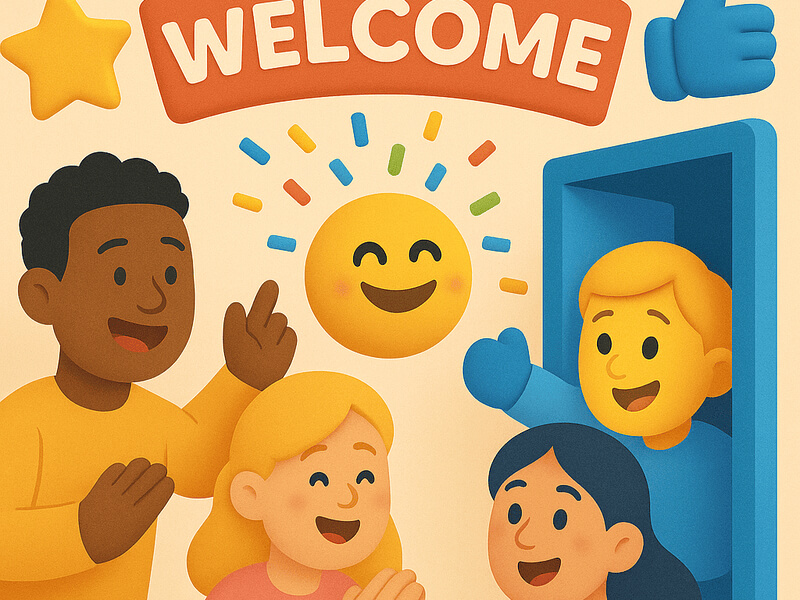
Creating effective peer nomination example templates helps organizations provide employees with concrete models they can use to celebrate their colleagues' contributions meaningfully. At Matter, we understand that many companies struggle to find quality peer nomination examples that demonstrate how to write compelling, specific nominations. Employees often feel uncertain about what to include in nominations or how to articulate their colleagues' achievements effectively. This uncertainty can lead to generic submissions that fail to capture the true impact of exceptional work.
Comprehensive peer nomination examples serve as valuable guides that show employees exactly how to structure their recognition submissions while highlighting different types of achievements and contributions. When organizations provide clear peer nomination example templates, employees gain confidence in their ability to write meaningful nominations that celebrate diverse accomplishments. These examples help eliminate guesswork from the nomination process while ensuring that recognition efforts are specific, authentic, and aligned with company values across all departments and teams.
What are peer nominations?
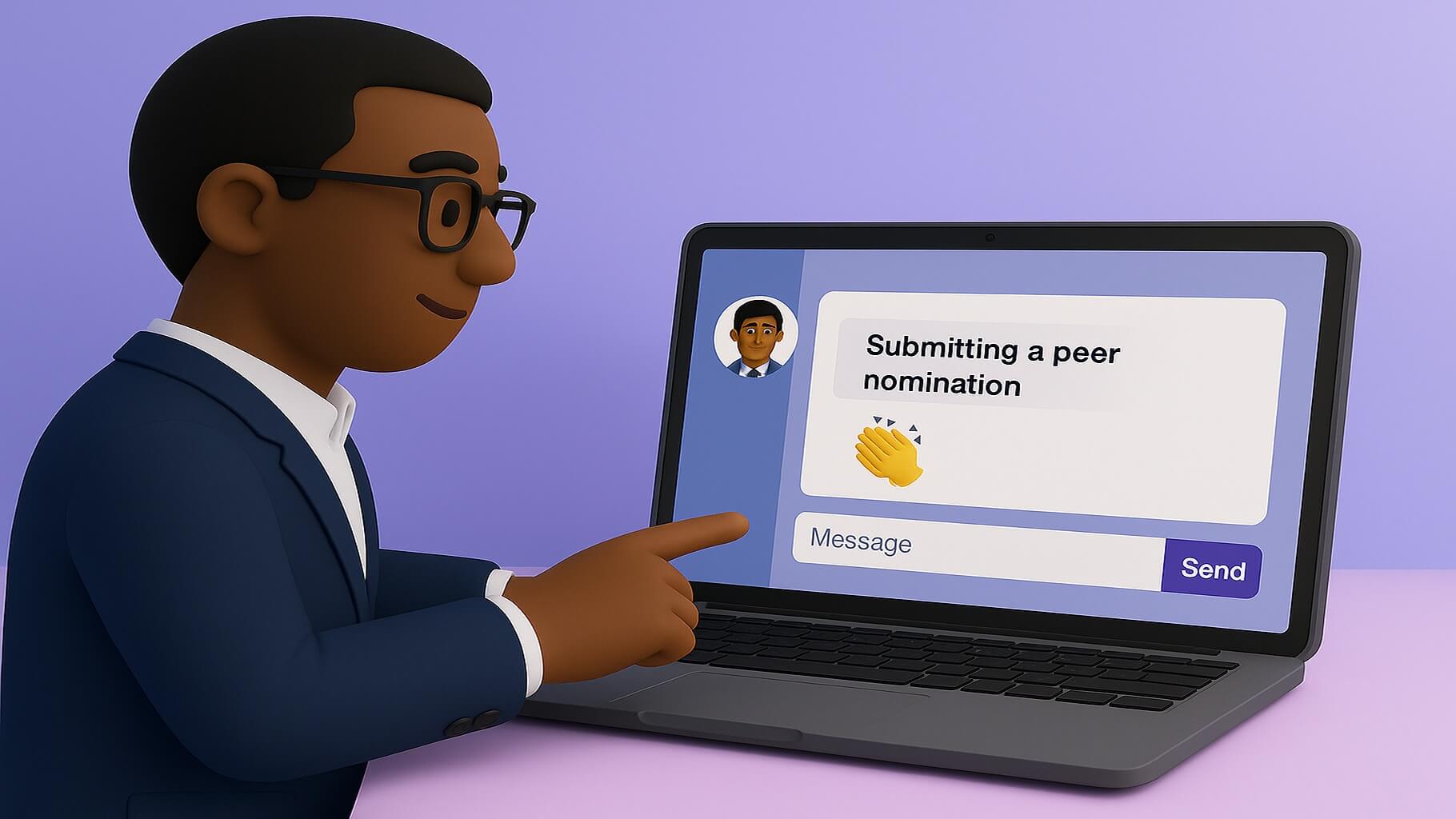
Peer nominations represent a structured approach to employee recognition where team members formally nominate colleagues for specific achievements, contributions, or demonstrations of company values. This systematic process differs from casual workplace appreciation by establishing clear criteria, submission procedures, and evaluation methods that ensure meaningful recognition consistently reaches deserving employees.
Understanding peer nominations in employee recognition programs
Peer nominations function as a cornerstone of comprehensive employee recognition programs by empowering team members to identify and celebrate exceptional contributions among their colleagues. This process creates opportunities for employees to acknowledge outstanding performance that might otherwise go unnoticed by management, fostering a culture of appreciation that extends beyond traditional top-down recognition approaches. Effective employee nomination systems provide structured frameworks that guide employees through the recognition process, ensuring a consistent and transparent approach. These systems ensure that all deserving contributions receive appropriate consideration and documentation.
The nomination process typically involves structured forms or digital platforms where employees can submit detailed descriptions of their peers' achievements. These submissions often include specific examples of how the nominee demonstrated the company's core values, exceeded expectations, or contributed to team success in measurable ways. Digital platforms streamline the submission process while maintaining comprehensive records of recognition efforts. Well-designed nomination systems make it easy for employees to participate while ensuring that submissions contain sufficient detail for evaluation.
Effective peer nomination systems establish clear categories for recognition, such as innovation, collaboration, leadership qualities, or exceptional performance. This categorization helps employees understand which behaviors and achievements deserve recognition, while ensuring that diverse contributions receive appropriate acknowledgment. Clear categories also help evaluators assess nominations fairly and consistently across different types of achievements. Structured recognition categories encourage employees to observe and appreciate various forms of excellence within their workplace.
How peer nominations differ from general peer-to-peer recognition
While general peer-to-peer recognition encompasses informal appreciation gestures, such as verbal thanks or quick acknowledgments, peer nominations require formal documentation and structured evaluation processes. This formalized approach ensures that recognition efforts maintain consistency and provide lasting records of employee achievements that can support career development discussions. Structured nomination for employee of the month programs exemplifies this formal approach to peer recognition. The systematic nature of formal nominations creates more meaningful and impactful recognition experiences.
Peer nominations typically involve submission deadlines, review processes, and formal announcement procedures that elevate the significance of the recognition. This structured framework enables organizations to track recognition patterns, identify high-performing individuals, and ensure an equitable distribution of appreciation across different departments and roles. The formal timeline and evaluation process demonstrate the organization's commitment to recognition, while creating anticipation and excitement around award announcements. These procedures also ensure that all nominations receive fair consideration and appropriate follow-up.
The formal nature of peer nominations also enables organizations to connect recognition directly to specific performance metrics and organizational values. This alignment enhances the impact of meaningful recognition by clearly demonstrating how individual contributions support broader company objectives and promote a positive work environment. Formal nominations create documentation that can be referenced during performance reviews and career development conversations. This connection between recognition and organizational goals helps reinforce desired behaviors while supporting employee growth and advancement opportunities.
Types of staff recognition that use formal peer nomination processes
Performance-based nominations focus on recognizing employees who consistently exceed expectations, meet challenging deadlines, or achieve remarkable results in their assigned responsibilities. Values-based nominations celebrate team members who exemplify organizational values through their daily actions and decision-making processes. Innovation and problem-solving nominations acknowledge employees who develop creative solutions and implement process improvements that advance organizational goals. Each category serves a specific purpose in constructing comprehensive recognition programs that address different aspects of employee excellence through effective employee recognition nomination examples.
Performance-based nominations typically include:
- Specific achievement descriptions that detail how employees exceeded expectations or met challenging deadlines
- Quantifiable improvements with measurable results that demonstrate impact on team or organizational success
- Quality standard examples showing exceptional dedication to maintaining high work standards
- Results documentation that proves the significance and value of the nominee's contributions
These nominations typically highlight specific achievements, quantifiable improvements, or exceptional dedication to quality standards that benefit the entire team. Performance-based recognition helps reinforce behaviors that drive measurable business outcomes while celebrating individual excellence.
Values-based nominations focus on:
- Daily action examples that show how nominees demonstrate organizational values in routine work situations
- Decision-making processes that reflect commitment to company principles and ethical standards
- Colleague interactions that exemplify respect, collaboration, and positive workplace behaviors
- Cultural contributions that strengthen organizational identity and shared purpose
These recognition examples often describe how nominees demonstrate integrity, innovation, collaboration, or other core values that strengthen workplace culture. Values-based nominations help reinforce desired behaviors while celebrating employees who embody organizational principles.
Innovation and problem-solving nominations highlight:
- Creative solution development that addresses workplace challenges through innovative thinking
- Process improvement implementations that enhance efficiency, quality, or effectiveness
- Valuable insights that contribute to strategic planning or operational enhancements
- Challenge resolution details, including specific problems addressed and positive outcomes achieved
These submissions typically detail specific challenges addressed, solutions implemented, and positive outcomes achieved through the nominee's efforts. Innovation nominations encourage creative thinking while recognizing employees who contribute meaningful improvements to organizational operations.
Why are peer nominations important for employee recognition
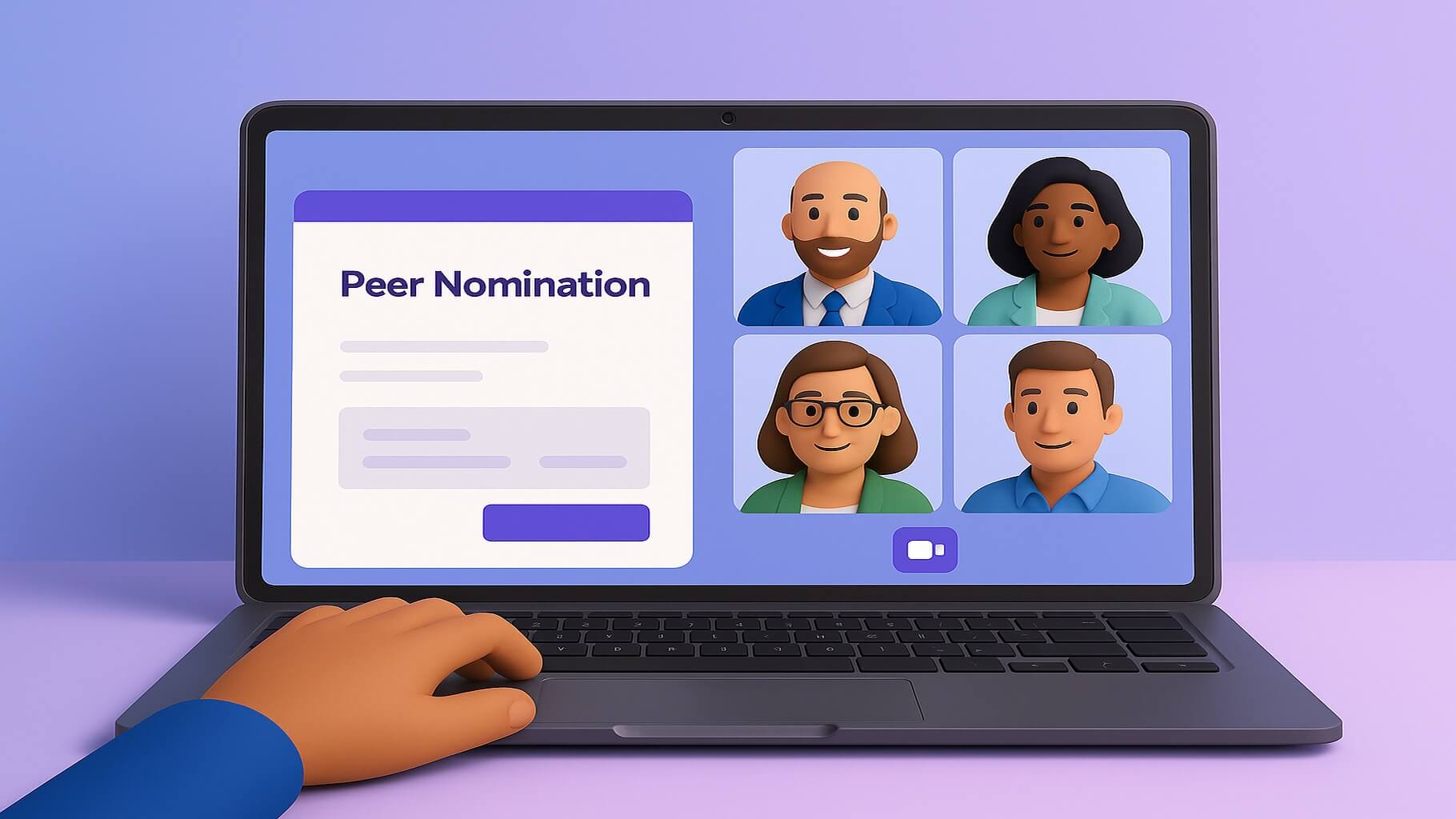
Peer nominations create powerful opportunities for meaningful recognition, strengthening workplace relationships and enhancing employee engagement across organizations. When team members take time to formally recognize their colleagues' contributions, it demonstrates mutual respect and appreciation that builds stronger collaborative foundations for long-term success. This structured approach to recognition ensures that achievements at all levels receive appropriate acknowledgment. Formal nomination processes help organizations capture and celebrate contributions that might otherwise go unnoticed.
Benefits of structured peer nomination examples for team recognition
Structured peer nomination processes ensure that recognition efforts reach employees at all organizational levels, resulting in a more equitable distribution of appreciation compared to traditional manager-only recognition approaches. This inclusivity helps boost employee morale by acknowledging contributions that peers observe daily but leadership might miss during routine operations. The formal documentation aspect provides valuable data for performance reviews and succession planning discussions. Effective team recognition through peer nominations creates comprehensive records of employee impact and contributions to the workplace culture.
Key benefits include:
- Equitable recognition distribution that reaches employees at all organizational levels, rather than focusing only on highly visible roles
- Enhanced collaboration through increased awareness of colleagues' contributions and achievements
- Valuable documentation for performance reviews, promotions, and succession planning discussions
- Stronger professional relationships across departments through mutual appreciation and respect
Peer nominations encourage employees to pay closer attention to their colleagues' work, fostering increased awareness of team achievements and individual contributions. This heightened awareness naturally leads to better collaboration and a more supportive work environment. The systematic approach helps identify patterns in high performance and exceptional teamwork that support strategic workforce planning.
Impact of peer-to-peer recognition through formal nominations
Formal peer nomination processes improve employee retention by fostering cultures in which all team members feel valued and appreciated for their individual contributions. When employees regularly receive recognition from their peers, they develop stronger emotional connections to their work and colleagues, which in turn reduces their turnover intentions. This emotional investment fosters lasting loyalty, benefiting both individual career satisfaction and organizational stability. Strong peer recognition cultures help employees feel more connected to their roles and committed to long-term success.
Recognition impact areas include:
- Increased employee retention through stronger emotional connections to work and colleagues
- Leadership development identification by recognizing emerging talent and high-potential employees
- A democratized recognition process that gives every employee a voice in appreciation decisions
- Enhanced engagement levels through collaborative approaches to celebrating achievements
The systematic nature of peer nominations helps identify patterns in high performance, exceptional teamwork, and leadership development opportunities that might otherwise remain unrecognized. Data from peer nominations provides valuable insights into employee strengths and development potential, supporting strategic workforce planning. Organizations can utilize this information to develop targeted programs and implement succession planning initiatives.
How to recognize employees effectively using peer nomination systems
Effective peer nomination systems provide clear guidelines that help employees craft compelling, specific nominations that highlight genuine achievements and contributions. These guidelines typically include examples of strong nominations, submission requirements, and evaluation criteria that ensure consistency and fairness throughout the process. Training sessions teach team members how to recognize nomination-worthy activities and craft effective descriptions. This education ensures that peer recognition efforts maintain quality standards while encouraging broader participation through comprehensive employee nomination sample resources.
Implementation best practices include:
- Clear submission guidelines with examples of effective nominations and evaluation criteria
- Consistent training sessions that instruct employees on how to recognize and document significant accomplishments
- Consistent feedback mechanisms that help employees understand what contributions receive recognition
- Systematic communication that maintains momentum for ongoing participation across all departments
Regular feedback about nomination outcomes helps employees understand what types of contributions receive recognition, encouraging them to continue observing and appreciating their colleagues' work. This ongoing communication strengthens the overall effectiveness of peer recognition programs while maintaining momentum for consistent participation. Effective systems create sustainable recognition cultures that celebrate achievements regularly rather than waiting for exceptional circumstances.
17 peer nomination examples by recognition category
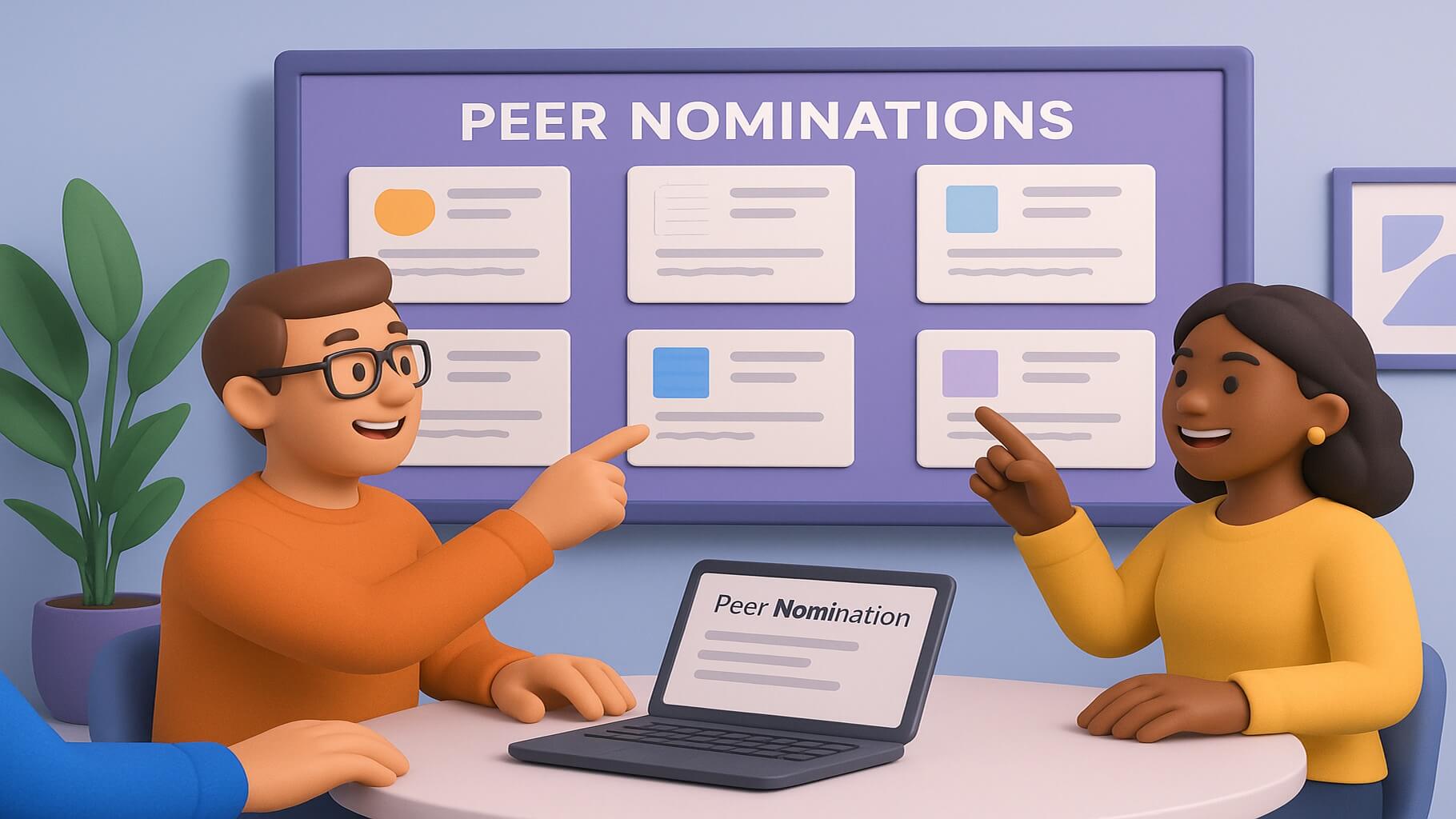
Effective peer nomination examples provide specific, detailed descriptions that clearly demonstrate how nominees contributed to team success, embodied company values, or achieved exceptional performance standards. These templates serve as valuable frameworks for employees who want to submit meaningful nominations that accurately reflect their colleagues' outstanding contributions. Well-crafted employee of the month nomination example templates help employees understand how to structure their submissions effectively. These examples demonstrate the level of detail and specificity required to create compelling nominations that truly honor colleagues' achievements.
5 outstanding performance peer nomination templates
1. Project Excellence Recognition Template
"I suggest [Employee Name] from our [Department] team for outstanding performance in [Specific Project/Initiative]. [Employee Name] regularly exceeded expectations by taking [Specific Action 1], [Specific Action 2], and [Specific Action 3] to achieve the desired outcome. Their steadfast focus yielded [Measurable Result], demonstrating their commitment to producing exceptional results."
2. Customer Service Excellence Template
"I would like to nominate [Employee Name] from our [Department] team for their remarkable dedication to client satisfaction. [Employee Name] transformed a potentially negative customer experience into a success story by [Specific Actions Taken]. Their approach not only resolved the immediate issue but also [Additional Positive Outcome] and demonstrated exceptional service standards."
3. Process Improvement Achievement Template
"I nominate [Employee Name] from [Department] for their outstanding contributions to [Specific Process/System] optimization. [Employee Name] identified inefficiencies in [Current Process] and developed an innovative solution that [Specific Improvement] while [Additional Benefit]. Their initiative required [Specific Efforts] and showcased their problem-solving abilities and commitment to continuous improvement."
4. Quality Standards Excellence Template
"I nominate [Employee Name] from our [Department] team for consistently maintaining the highest standards while [Specific Challenge/Context]. [Employee Name]'s attention to detail [Specific Achievement] and [Positive Impact]. Their thorough approach and positive attitude make them an invaluable team member who elevates our entire [Process/Department]."
5. Revenue Impact Recognition Template
"I nominate [Employee Name] from our [Department] team for their exceptional performance in [Specific Achievement Area]. [Employee Name]'s [Relevant Skills] resulted in [Specific Results] that not only [Immediate Impact] but also [Long-term Benefit]. Their [Approach/Qualities] exemplify the leadership qualities we value in our organization."
6 collaboration and teamwork peer recognition templates
1. Cross-Department Collaboration Template
"I nominate [Employee Name] from the [Department] team for their outstanding collaborative efforts during [Specific Project/Initiative]. [Employee Name] worked closely with [Departments/Teams] to ensure [Specific Goal]. Their ability to [Specific Skills] made all the difference in delivering [Outcome] that reflected our core values."
2. Mentorship and Support Template
"I nominate [Employee Name] from our [Department] team for their exceptional dedication to supporting [Target Group] integration and growth. [Employee Name] consistently [Specific Actions] and creates an inclusive environment where [Specific Benefit]. Their mentorship approach has significantly improved [Measurable Impact] and demonstrates how mutual respect enhances workplace culture."
3. Crisis Management Teamwork Template
"I nominate [Employee Name] from our [Department] team for their remarkable teamwork during [Specific Crisis/Challenge]. [Employee Name] [Specific Actions Taken] and ensured that [Positive Outcome]. Their calm leadership and collaborative approach helped [Specific Result] and demonstrated exceptional teamwork under pressure."
4. Knowledge Sharing Initiative Template
"I nominate [Employee Name] from our [Department] team for creating and leading [Specific Initiative] that benefits the entire organization. [Employee Name] recognized the need for [Specific Need] and developed [Solution/Program] that encourages [Desired Outcome]. Their initiative has [Specific Impact] and created opportunities for [Additional Benefits] across teams."
5. Team Integration Success Template
"I nominate [Employee Name] from our [Department] team for their outstanding efforts in [Specific Integration Challenge]. [Employee Name] developed [Specific Solutions] and ensured that [Target Group] felt [Desired Outcome]. Their inclusive approach has strengthened [Specific Improvement] and created a more supportive work environment for everyone."
6. Conflict Resolution Excellence Template
"I nominate [Employee Name] from our [Department] team for their exceptional skill in resolving [Specific Conflict/Challenge]. [Employee Name] demonstrated [Specific Approach] and facilitated [Resolution Method] that resulted in [Positive Outcome]. Their diplomatic approach and [Relevant Skills] have improved team dynamics and established better communication practices."
6 innovation and problem-solving staff recognition templates
1. Technology Innovation Recognition Template
"I nominate [Employee Name] from our [Department] department for developing an innovative [Solution Type] that [Specific Improvement]. [Employee Name] identified inefficiencies in [Current System] and created a solution that [Specific Benefits]. Their creative approach to problem-solving and willingness to explore new technologies demonstrate the innovative thinking that drives our company's success."
2. Process Innovation Achievement Template
"I nominate [Employee Name] from our [Department] team for their innovative approach to [Specific Area] optimization. [Employee Name] developed [Specific Solution] that improved [Specific Metrics] by implementing [Method/Approach]. Their solution required [Specific Efforts] that resulted in [Measurable Benefits] and operational improvements."
3. Customer Experience Innovation Template
"I nominate [Employee Name] from our [Department] team for creating an innovative [Solution/System] that transformed how we [Specific Process]. [Employee Name]'s solution [Specific Features/Benefits] that provides [Specific Value]. Their innovative approach has enhanced [Specific Improvement] and improved our ability to [Specific Capability]."
4. Training Program Innovation Template
"I nominate [Employee Name] from our [Department] team for designing an innovative [Program Type] that combines [Approach 1] with [Approach 2]. [Employee Name]'s creative approach addresses [Specific Challenge] while providing [Specific Benefits] that improve [Desired Outcome]. Their program has received [Specific Feedback] and demonstrates how innovative thinking can enhance [Specific Area]."
5. Communication Innovation Template
"I nominate [Employee Name] from our [Department] team for developing an innovative [Communication Method] that increased [Specific Metric] and [Additional Benefit]. [Employee Name] recognized that [Previous Challenge] and created [Solution] that accommodates [Specific Needs]. Their innovation has improved [Specific Improvement] throughout the entire organization."
6. Sustainability Innovation Template
"I nominate [Employee Name] from our [Department] team for implementing innovative [Sustainability Initiative] that reduced [Environmental Impact] while [Additional Benefit]. [Employee Name] researched [Specific Area], developed [Implementation Strategy], and coordinated [Team Efforts] to achieve [Specific Results]. Their commitment to [Environmental Values] has positioned our organization as a leader in sustainable practices."
15 employee recognition examples through peer nominations

Peer-submitted recognition examples demonstrate how colleagues can effectively acknowledge each other's contributions while strengthening team bonds and encouraging continued excellence. These employee recognition examples demonstrate various approaches to highlighting achievements, collaborative efforts, and positive influences that make meaningful contributions to workplace dynamics. Effective peer-to-peer award nomination examples provide concrete models that employees can adapt for their own nomination submissions. These examples help employees understand what makes recognition meaningful while inspiring them to celebrate their colleagues' achievements in compelling and authentic ways.
4 peer-submitted employee recognition examples for excellence
1. Technical Excellence Recognition
“I submit this nomination for Tom from our engineering team, who consistently delivers high-quality solutions that exceed technical requirements. Tom's expertise in database optimization has improved system performance across multiple applications, while his willingness to share knowledge has elevated our entire team's capabilities. His technical excellence and collaborative spirit make him such a pleasure to work with and an invaluable contributor to our project success."
2. Leadership Excellence Through Mentorship
"I nominate Patricia from our project management team for demonstrating exceptional leadership through her mentoring approach with junior team members. Patricia creates learning opportunities, provides constructive feedback, and ensures that everyone feels supported in their professional development. Her leadership style encourages growth while maintaining high performance standards that benefit our entire team."
3. Client Relationship Excellence
"I suggest Robert from our account management team for his exceptional ability to establish and maintain excellent customer connections, which drive business success. Robert's proactive communication style, problem-solving approach, and genuine concern for customer results have led to higher satisfaction rates and contract renewals. His effectiveness in relationship management illustrates our dedication to customer satisfaction.
4. Creative Excellence Recognition
"I nominate Diana from our design team for her exceptional creativity and attention to detail that elevates every project she touches. Diana's innovative design solutions consistently exceed client expectations while her collaborative approach ensures that creative vision aligns with practical implementation requirements. Her creative excellence contributes significantly to our team's reputation and project success."
4 team recognition peer nomination examples
1. Collaborative Team Achievement
"I nominate our entire cross-functional product team for their outstanding collaborative efforts during our recent feature release. This team demonstrated exceptional coordination between the design, development, and testing phases, while maintaining open communication and supporting one another through challenges. Their collective dedication and teamwork resulted in a successful launch that exceeded user adoption targets."
2. Innovation Team Recognition
"I nominate our research and development team for their collaborative innovation during the quarterly hackathon event. The team's ability to combine diverse perspectives, share resources effectively, and support one another's ideas has resulted in breakthrough solutions that are now being implemented company-wide. Their teamwork exemplifies how collaborative efforts can drive meaningful innovation."
3. Crisis Response Team Excellence
"I nominate our customer support team for their exceptional collaborative response during the recent service disruption. The team maintained clear communication, divided responsibilities effectively, and worked together to minimize customer impact while resolving underlying issues. Their coordinated effort and mutual support demonstrated how effective teamwork can turn challenging situations into opportunities to strengthen customer relationships."
4. Training Team Collaboration
"I nominate our learning and development team for their outstanding collaboration in creating comprehensive onboarding programs for new employees. The team's coordinated approach to curriculum development, resource creation, and delivery methods has significantly improved new hire integration and satisfaction scores. Their teamwork has created lasting improvements to our employee experience."
4 positive recognition examples from colleague nominations
1. Identifying Positive Attitudes
"I'd like to propose Jake from our customer support team for his continual good attitude, which boosts our entire department. Jake's positive attitude toward problems, desire to assist coworkers, and genuine excitement for his work foster an environment in which everyone feels driven and supported. His positive influence has a huge impact on our daily work experience."
2. Supportive Colleague Recognition
"I nominate Emma from our finance team for being an incredibly supportive colleague who always makes time to help others succeed. Emma shares her expertise generously, offers assistance during busy periods, and provides encouragement when teammates face challenges. Her supportive nature and consistent dedication create a more positive work environment for everyone."
3. Communication Excellence Recognition
"I nominate Chris from our marketing team for his exceptional communication skills that facilitate better collaboration across all departments. Chris ensures that everyone stays informed about project developments, asks thoughtful questions that clarify requirements, and provides updates that help teams coordinate effectively. His communication excellence contributes significantly to our overall project success."
4. Reliability Recognition
"I nominate Angela from our operations team for her outstanding reliability and consistent delivery of high-quality work. Angela meets every deadline, anticipates potential issues, and provides solutions before problems impact team productivity. Her reliability and proactive approach make her an essential team member who contributes significantly to our operational excellence."
3 service excellence and innovation peer recognition examples
1. Process Improvement Innovation
"I nominate Kevin from our quality assurance team for developing innovative testing procedures that reduced defect rates by 40% while streamlining our review processes. Kevin identified inefficiencies in our current workflow and proposed practical solutions that saved time and improved accuracy. His initiative to collaborate with multiple departments resulted in company-wide process improvements that continue benefiting our operations."
2. Customer Service Excellence
"I want to recognize Lisa from our client relations department for always going above and beyond to ensure customer happiness and loyalty. There is a 98% client retention rate in Lisa's portfolio as a result of her inventive problem-solving abilities and proactive communication style. Her attention to understanding customer needs and creating unique solutions shows our commitment to service excellence."
3. Technology Innovation Leadership
"I nominate Marcus from our IT department for leading the implementation of automated systems that increased operational efficiency by 35% while reducing manual errors. Marcus researched emerging technologies, developed implementation strategies, and provided comprehensive training to ensure smooth transitions. His innovative approach to technology solutions has positioned our organization for continued growth and competitiveness."
10 peer-to-peer recognition ideas with nomination templates
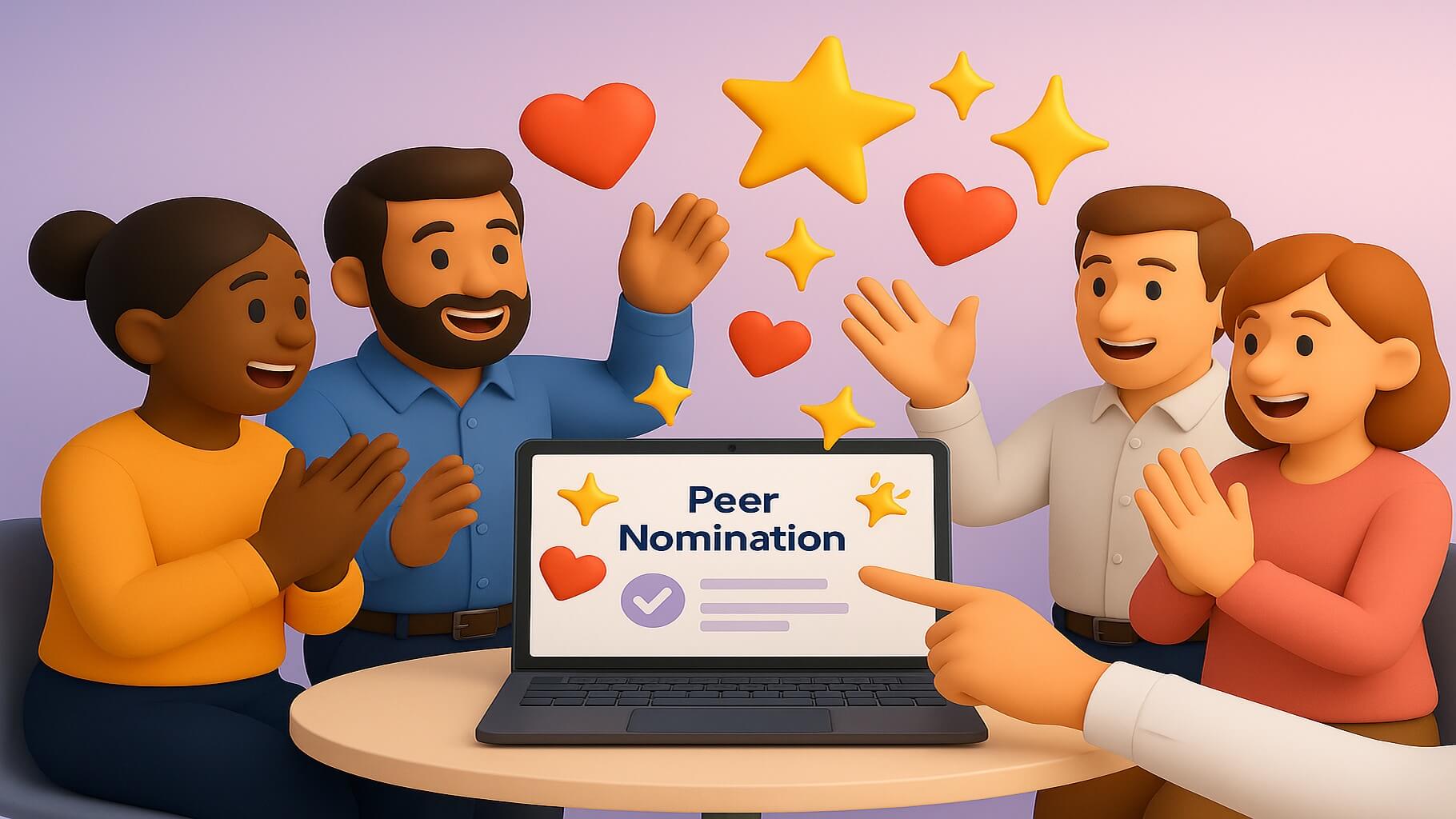
Effective peer nomination templates provide structured frameworks that help employees submit comprehensive and meaningful recognition, accurately capturing their colleagues' contributions and achievements. These templates ensure consistency while allowing for personalization that makes each nomination unique and impactful for both nominees and the recognition programs that support them. Well-designed employee of the month nomination template frameworks provide clear guidance while maintaining flexibility for individual customization. The right template structure helps employees organize their thoughts and present compelling cases for recognition while reducing the complexity of the nomination process.
4 formal peer nomination template examples
1. Achievement-Based Nomination Template
"Nominee Name: [Employee Name] Department: [Department Name] Achievement Category: [Performance/Innovation/Leadership]
Specific Achievement Description: I nominate [Name] for their outstanding contribution to [specific project/initiative]. [Name] demonstrated exceptional [skill/quality] by [detailed description of actions taken]. The impact of their efforts included [specific outcomes and benefits].
Supporting Details:
- Timeline: [When the achievement occurred]
- Measurable Results: [Quantifiable outcomes when possible]
- Team Impact: [How it benefited colleagues or the organization]
- Values Alignment: [How it reflects the company's core values]
This nomination recognizes [Name]'s consistent dedication and the positive influence their work has on our entire team."
2. Values-Based Nomination Template
"Nominee Information: [Name and Department] Core Value Demonstrated: [Specific company value]
Detailed Narrative: I am pleased to nominate [Name] for exemplifying our value of [specific value] through their daily actions and decision-making. [Name] consistently demonstrates this value by [specific examples of behavior]. Their approach to [specific situation/responsibility] shows how embracing our core values leads to better outcomes for everyone.
Impact Statement: [Name]'s commitment to [value] has resulted in [specific positive outcomes]. Their example encourages other team members to embody this value in their own work, creating a positive ripple effect throughout our department.
This nomination highlights how [Name] makes our organizational values meaningful through practical application and inspiring leadership."
3. Collaboration-Focused Nomination Template
"Collaborative Achievement Nomination Nominee: [Employee Name] Collaboration Partners: [Other team members/departments involved]
Project/Initiative: [Name of collaborative effort] Duration: [Timeline of collaboration]
Collaboration Excellence Description: I nominate [Name] for their exceptional collaborative efforts during [project/initiative]. [Name] facilitated effective communication between [parties involved], ensuring that all perspectives were heard and integrated into our approach. Their ability to [specific collaborative skills] made all the difference in achieving our objectives.
Team Benefits:
- Enhanced communication across [departments/teams]
- Improved project outcomes through [specific improvements]
- Strengthened working relationships with [relevant parties]
- Knowledge sharing that benefited [broader group]
[Name]'s collaborative approach demonstrates how mutual respect and open communication create better results for everyone involved."
4. Innovation and Problem-Solving Template
"Innovation Recognition Nomination Innovator: [Employee Name] Innovation Category: [Process improvement/Technology/Creative solution]
Challenge Addressed: [Name] identified [specific problem/opportunity] and developed an innovative approach to [solution description]. Their creative thinking and problem-solving abilities resulted in [specific improvements/outcomes].
Innovation Details:
- Problem Analysis: [How they identified and understood the challenge]
- Solution Development: [Their approach to creating solutions]
- Implementation Process: [How they executed their ideas]
- Results Achieved: [Measurable outcomes and benefits]
This innovation demonstrates [Name]'s ability to think creatively, implement effective solutions, and contribute valuable insights that advance our organizational goals."
3 quick peer recognition nomination formats
1. Impact-Focused Quick Format
"Quick Recognition Nomination for [Name] Achievement: [Brief description of what they accomplished] Impact: [How it benefited the team/organization] Why it matters: [Connection to company values or goals] Submitted by: [Your name and department]"
2. Behavior-Based Quick Format
"Peer Recognition Submission Nominee: [Name] Behavior observed: [Specific actions or qualities demonstrated] Situation: [Context where this behavior was displayed] Outcome: [Positive results of their actions] Recommendation: [Why they deserve recognition]"
3. Achievement Highlight Format
"Recognition Nomination Team Member: [Name] Achievement Category: [Performance/Collaboration/Innovation] Key Contribution: [Primary accomplishment or behavior] Team Benefit: [How it helped colleagues or projects] Nomination Reason: [Why this deserves formal recognition]"
3 creative peer nomination submission ideas
1. Story-Based Nomination Approach:
"I'd like to share a story about [Name] that perfectly captures why they deserve recognition. Last month, when our team faced a [challenging situation], [Name] stepped up by [specific actions taken]. What made this special wasn't just the solution they provided, but how they [collaborative or supportive behaviors]. The result was [positive outcome], but more importantly, [Name] showed us how [relevant value or quality] can make a real difference in how we work together."
2. Multi-Perspective Nomination
"This nomination comes from multiple colleagues who have witnessed [Name]'s exceptional contributions:
From [Department A]: '[Name] consistently provides valuable insights that help us understand [specific area] better.' From [Department B]: 'Working with [Name] on [project] was such a pleasure because of their [specific qualities].' From [Department C]: '[Name]'s support during [situation] demonstrated their commitment to our team's success.'
Collectively, we recognize [Name] for [primary achievement/quality] and their positive influence across our entire organization."
3. Before-and-After Impact Nomination
"Before [Name] joined our [project/team/initiative]: [Description of previous situation or challenges]
After [Name]'s involvement: [Description of improvements and positive changes]
[Name]'s specific contributions included [detailed actions taken], which resulted in [measurable improvements]. Their approach to [relevant area] transformed not just our results, but also how we collaborate and support each other. This nomination recognizes how one person's dedication and expertise can elevate an entire team's performance."
11 staff recognition peer nomination examples by workplace setting
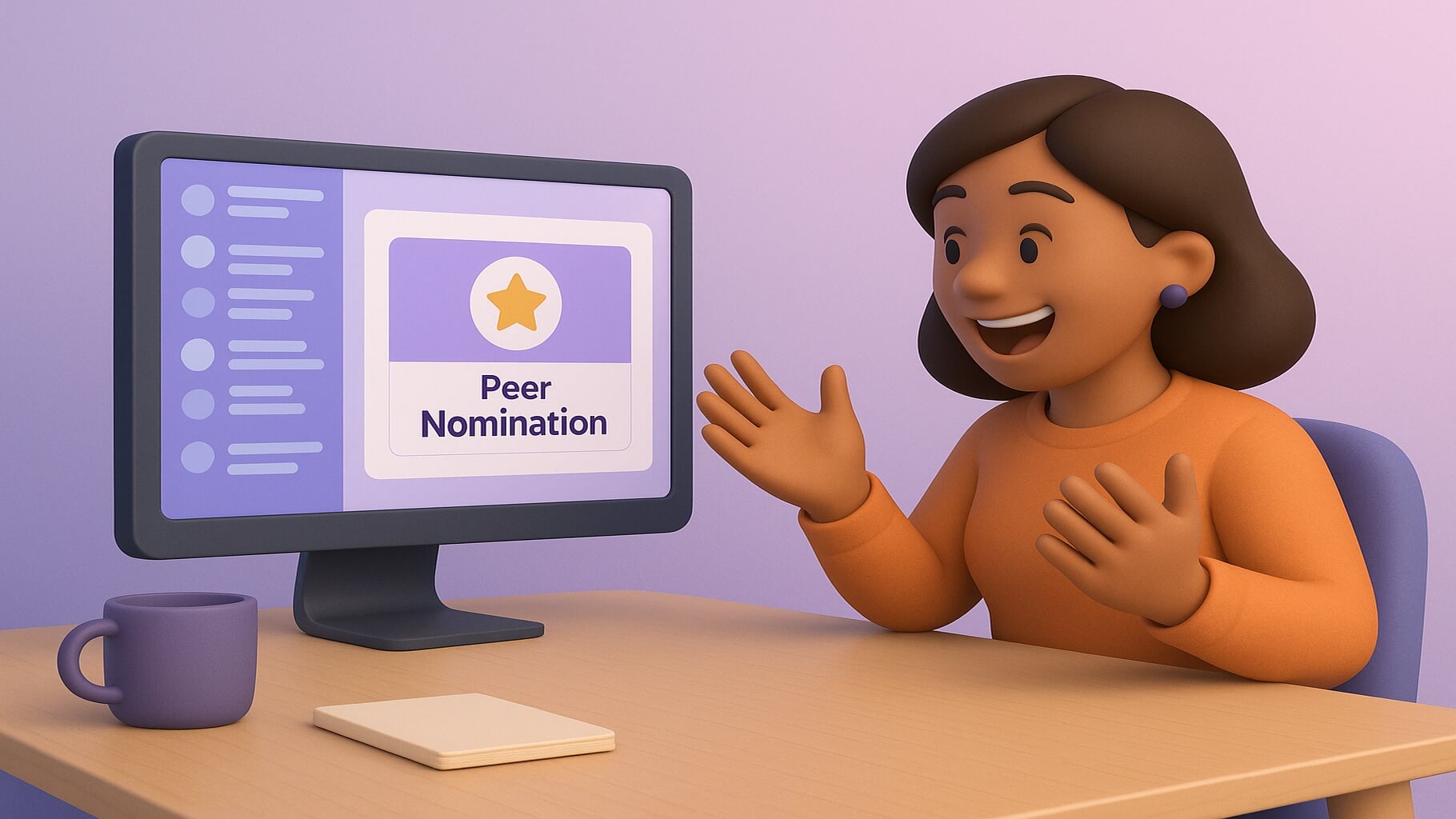
Modern workplace environments require tailored peer nomination approaches that account for different communication styles, collaboration methods, and recognition delivery preferences. These setting-specific examples help organizations implement effective recognition programs that reach all employees regardless of their work location or preferred interaction methods. These comprehensive staff nomination examples provide frameworks that can be adapted for any workplace configuration. Organizations can customize these templates to reflect their unique culture, values, and recognition priorities.
3 remote work peer nomination examples
1. Virtual Collaboration Excellence Template
"I nominate [Employee Name] from our remote [Department] team for their exceptional ability to maintain team cohesion and productivity across different time zones. [Employee Name] consistently ensures that all remote employees feel included in decision-making processes by scheduling flexible meeting times, creating comprehensive project documentation, and facilitating asynchronous collaboration through digital platforms. Their efforts have made remote work feel seamless and connected, demonstrating how thoughtful communication can bridge physical distances."
2. Digital Communication Leadership Template
"I nominate [Employee Name] from our remote [Department] team for transforming our virtual communication practices through innovative use of collaborative tools and fostering open communication channels. [Employee Name] established weekly virtual coffee sessions, implemented peer mentoring partnerships, and created digital spaces where team members can share both professional insights and personal updates. Their initiative has strengthened relationships among remote employees and created a more supportive work environment despite physical separation."
3. Remote Onboarding Excellence Template
"I nominate [Employee Name] from our [Department] team for developing an outstanding remote onboarding program that helps new team members integrate and succeed in our distributed work environment. [Employee Name] created virtual meet-and-greet sessions, established buddy systems for new hires, and developed comprehensive digital resources that help remote employees understand our company culture and connect with colleagues. Their program has significantly improved new hire satisfaction and reduced the time needed for effective team integration."
5 in-office team recognition peer nomination examples
1. Workplace Culture Enhancement Template
"I suggest [Employee Name] from our in-office [Department] team for fostering an inclusive and energizing workplace culture that promotes cooperation and mutual support. [Employee Name] holds frequent team meetings to celebrate project milestones, maintains an open-door policy that encourages inquiries and suggestions, and consistently honors colleagues' accomplishments through official and informal recognition techniques. Their efforts have altered our office climate into one in which everyone feels respected and inspired to do their best work."
2. Cross-departmental Facilitation Template
"I recommend [Employee Name] from our in-office [Department] team because of their remarkable ability to promote communication and collaboration among the various departments that share our workspace. [Employee Name] routinely organizes interdepartmental lunches, facilitates information sharing across teams, and assists in dispute resolution through diplomatic and effective communication. Their initiatives have enhanced working relationships throughout the firm and proven how one individual can favorably impact workplace culture."
3. Mentorship and Development Leadership Template
"I nominate [Employee Name] from our in-office [Department] team for their exceptional commitment to mentoring junior colleagues and creating learning opportunities that benefit our entire office community. [Employee Name] hosts weekly skill-sharing sessions, provides constructive feedback that helps others grow professionally, and consistently makes time to answer questions and provide guidance. Their mentorship approach has elevated our team's capabilities while creating an environment where continuous learning thrives."
4. Innovation and Process Improvement Template
"I nominate [Employee Name] from our in-office [Department] team for their innovative approaches to streamlining workplace processes and improving operational efficiency. [Employee Name] identified inefficiencies in our current workflows, developed creative solutions that reduced processing time, and collaborated with multiple departments to implement improvements. Their initiative has resulted in significant productivity gains while demonstrating how individual innovation can benefit the entire organization."
5. Customer Service Excellence Template
"I nominate [Employee Name] from our in-office [Department] team for their exceptional dedication to customer satisfaction and relationship building. [Employee Name] consistently goes above and beyond to resolve client concerns, develops personalized solutions that exceed expectations, and maintains positive relationships that strengthen our company's reputation. Their commitment to service excellence has resulted in increased customer retention and demonstrates the positive influence that dedicated employees can have on business outcomes."
3 hybrid workplace peer-to-peer recognition nominations
1. Flexible Communication Excellence Template
"I recommend [Employee Name] from our hybrid [Department] team to effectively manage communication and collaboration among remote and in-office team members. [Employee Name] ensures that virtual participants participate equally in in-person meetings, creates shared digital spaces for ongoing collaboration, and customizes their communication style to different working preferences. Their technique has contributed to the success of our hybrid model by guaranteeing that all team members, regardless of physical location, may contribute effectively.
2. Inclusive Team Building Innovation Template
"I nominate [Employee Name] from our hybrid [Department] team for developing innovative team-building approaches that bring together remote and in-office employees in meaningful ways. [Employee Name] organizes virtual-physical hybrid events, creates collaborative projects that leverage both digital and in-person interaction strengths, and ensures that team achievements are celebrated in ways that include everyone. Their initiatives have strengthened our team bonds and demonstrated how hybrid workplaces can combine the best aspects of remote and traditional office environments."
3. Technology Integration Leadership Template
"I nominate [Employee Name] from our hybrid [Department] team for their outstanding ability to integrate technology solutions that support seamless collaboration between remote and in-office team members. [Employee Name] implemented new digital tools that improve workflow efficiency, established protocols for hybrid meeting management, and provided training that helps all employees maximize technology benefits. Their technical leadership has enhanced our hybrid work capabilities while ensuring that productivity remains high across all work environments."
How to create effective peer nomination examples

Creating compelling peer nominations requires understanding what elements make recognition meaningful, specific, and impactful for both nominees and the broader organization. Effective nominations go beyond simple appreciation to provide detailed examples that demonstrate how individual contributions align with company values and drive positive outcomes. The most successful nominations include concrete evidence of achievements while connecting individual efforts to broader organizational success. Well-crafted nominations serve as powerful tools for reinforcing desired behaviors and strengthening workplace culture across all departments, as demonstrated in comprehensive employee of the year nomination examples.
Essential components of compelling peer recognition examples
Strong peer nominations begin with specific, observable behaviors and achievements that clearly demonstrate the nominee's impact on team performance metrics, project outcomes, or workplace culture improvements. These detailed descriptions help readers understand exactly what the nominee accomplished and why their contributions deserve formal recognition and appreciation. Background information helps evaluators understand the complexity of the nominee's contributions and the skills required to achieve positive results. The most compelling nominations also demonstrate how the nominee's efforts support company success while reinforcing desired behaviors throughout the organization.
Key components of effective nominations include:
- Specific context that explains the situation or challenge the nominee addressed, making their achievements more meaningful and relatable.
- Observable behaviors and concrete actions that demonstrate the nominee's direct contributions to positive outcomes
- Measurable results, including metrics, timelines, or quantifiable outcomes that prove the significance of contributions
- Values alignment that connects individual achievements to broader organizational goals and core values
Effective nominations include sufficient context to make achievements meaningful while maintaining focus on the most important contributions. Quantifiable outcomes and specific examples provide concrete evidence of the nominee's impact, making nominations more credible and compelling. When possible, effective nominations include metrics, timelines, or other measurable results that demonstrate the significance of the nominee's contributions. This evidence-based approach enables evaluators to understand the true value of the nominee's work, thereby supporting fair and consistent recognition decisions.
Writing techniques for impactful employee recognition nominations
Begin nominations with strong opening statements that immediately capture the nominee's most significant achievement or contribution. This approach ensures that key information is communicated clearly, even if readers only scan the first few sentences of the submission. Strong openings create immediate engagement while setting the tone for the entire nomination. Effective writers focus on the most impactful achievements first to ensure maximum attention from evaluators, as demonstrated in compelling leadership award nomination example templates.
Effective writing techniques include:
- Active voice and specific action verbs that clearly describe accomplishments rather than passive language
- Storytelling elements that help readers visualize the nominee's actions and understand their impact on colleagues
- Professional tone balanced with genuine enthusiasm that reflects sincere appreciation for contributions
- Clear structure that presents information logically and makes nominations easy to read and evaluate
Use active voice and specific action verbs that clearly describe what the nominee accomplished rather than passive language that obscures their direct contributions. Incorporate storytelling elements that help readers visualize the nominee's actions while balancing professional tone with authentic emotion that conveys meaningful appreciation. Well-crafted narratives make nominations more memorable and emotionally engaging for both evaluators and recipients. Authentic emotion in nomination writing helps convey the meaningful impact that recognition can have on employee morale and motivation.
Best practices for how to recognize employees through peer nominations
Establish clear submission guidelines that help nominators understand what information to include, how much detail to provide, and what types of achievements deserve formal recognition. These guidelines ensure consistency while helping employees craft more effective employee nomination submissions. Clear standards help maintain quality across all nominations while reducing confusion about submission requirements. Comprehensive guidelines also help ensure that all deserving contributions receive appropriate consideration regardless of the nominator's writing experience.
Implementation best practices include:
- Clear submission guidelines that specify required information, detail levels, and recognition criteria
- Training programs that demonstrate how to identify nomination-worthy behaviors and write compelling descriptions
- Regular submission opportunities with systematic reminders that encourage consistent participation
- Feedback mechanisms that help nominators understand what elements make nominations most effective
Provide training and examples that demonstrate how to identify nomination-worthy behaviors and write compelling descriptions that accurately capture colleagues' contributions. This education helps employees understand the nomination process while encouraging broader participation in recognition programs. Create regular submission opportunities and reminders that encourage consistent participation while ensuring that deserving achievements receive timely recognition through systematic approaches. Implement feedback mechanisms that help nominators understand how their submissions contribute to overall recognition programs and what elements make nominations most effective.
Common mistakes in peer nomination examples
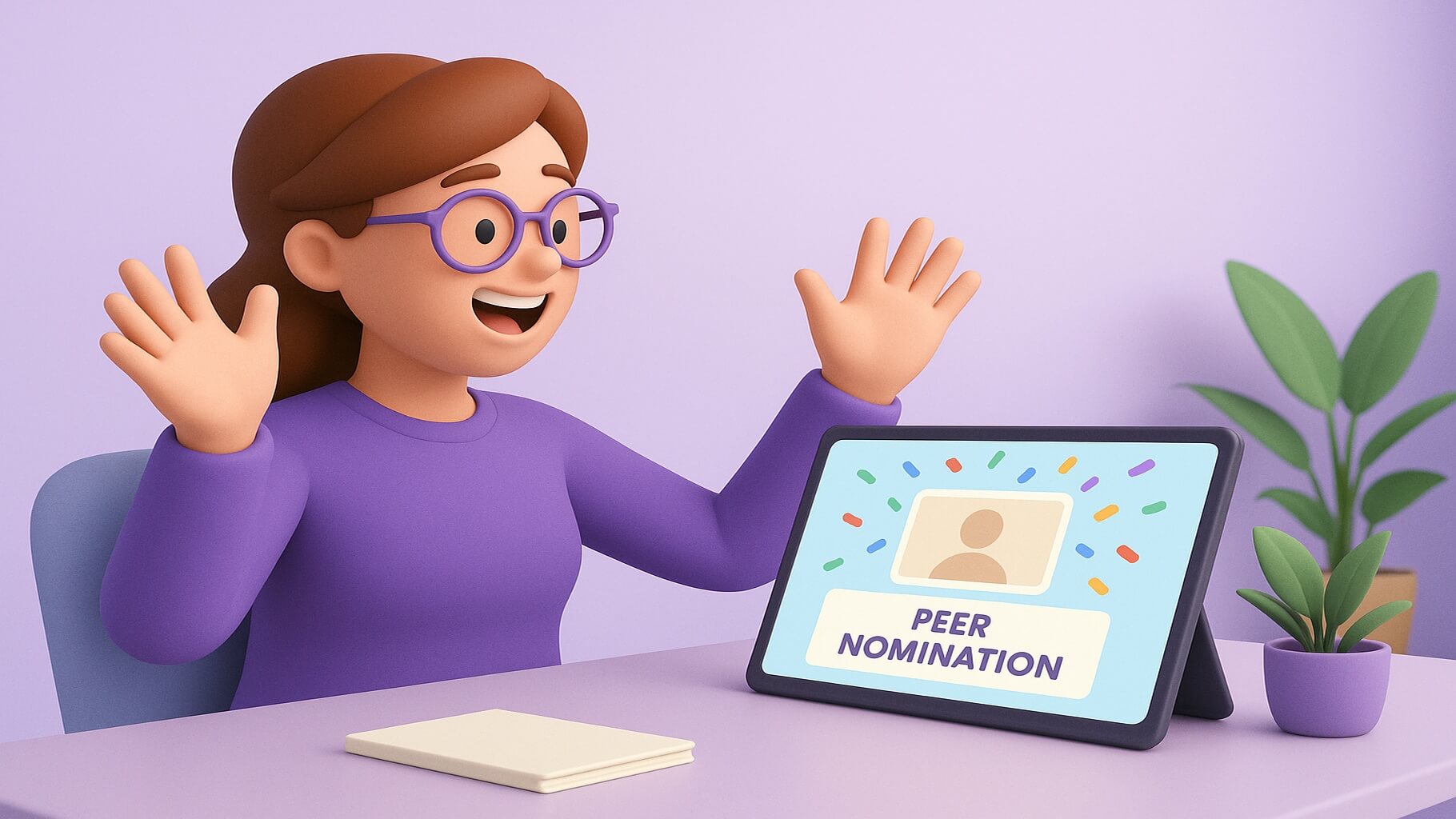
Understanding common pitfalls in peer nomination writing helps organizations enhance their recognition programs, ensuring that submissions effectively highlight the contributions of deserving colleagues. These mistakes often reduce the impact of recognition efforts and may discourage participation in peer recognition programs. Identifying and addressing these issues early helps organizations build more effective recognition systems. By learning from common errors, organizations can provide more effective guidance to employees and enhance overall nomination quality.
Content errors that weaken peer-to-peer recognition impact
Generic language and vague descriptions fail to capture the specific nature of nominees' contributions, making nominations less compelling and meaningful for both recipients and evaluators. Phrases like "great job" or "excellent work" don't provide enough detail to understand what makes the achievement noteworthy or deserving of formal recognition. Vague language reduces the credibility of nominations while failing to provide useful information for evaluation purposes. Specific, detailed descriptions are essential for creating nominations that truly honor the nominee's contributions, as shown in effective employee of the quarter nomination example templates.
Common content errors include:
- Vague descriptions that use generic language instead of specific achievement details
- Personality focus rather than observable behaviors and measurable contributions
- Irrelevant information that doesn't directly relate to the nominee's achievements
- The missing values connection that fails to link contributions to organizational goals
Focusing on personality traits rather than observable behaviors and specific achievements reduces the credibility and usefulness of nominations. While positive attitude and pleasant demeanor contribute to workplace culture, effective nominations should emphasize concrete actions and measurable contributions that demonstrate professional excellence. Including irrelevant information or excessive background details that don't directly relate to the nominee's achievements can dilute the impact of key messages. Failing to connect individual achievements to broader organizational goals or company values misses opportunities to reinforce desired behaviors and demonstrate alignment with company priorities.
Process mistakes in staff recognition peer nomination programs
Submitting nominations without adequate review or proofreading can result in unclear communication, factual errors, or incomplete information that reduces the professionalism and impact of recognition efforts. Taking the time to modify and polish nominations ensures that they convey the intended message while adhering to professional guidelines. Poor quality submissions reflect negatively on both the nominator and the nominee, potentially reducing the impact of recognition efforts. Careful review processes help ensure that nominations accurately represent the nominee's achievements and contributions.
Process-related mistakes include:
- Insufficient review resulting in unclear communication or factual errors
- Missed deadlines that prevent timely recognition and create an administrative burden
- Repetitive nominations that create perceptions of favoritism across teams
- Inadequate documentation makes it difficult to assess the contribution's significance
Missing submission deadlines or failing to follow established procedures can prevent deserving colleagues from receiving timely recognition while creating additional administrative burden for program coordinators. Understanding and adhering to established processes helps ensure that recognition programs function smoothly and effectively. Nominating the same individuals repeatedly without recognizing diverse contributions across teams can create perceptions of favoritism and reduce program credibility. Providing insufficient detail or documentation to support nomination claims makes it difficult for evaluators to assess the significance of contributions. It may result in deserving nominees being overlooked for recognition awards.
Timing and submission errors that reduce nomination effectiveness
Submitting nominations long after achievements occurred reduces their relevance and impact while making it harder to provide specific details about the nominee's contributions. Timely recognition is more meaningful for recipients and helps maintain the connection between achievements and the acknowledgment of them. Delayed submissions also reduce the emotional impact of recognition while potentially affecting the nominee's memory of the specific achievement. Fresh recognition creates stronger connections between achievements and appreciation, enhancing the overall effectiveness of recognition efforts, particularly in regular programs like team member of the month nomination sample initiatives.
Timing-related errors include:
- Delayed submissions that reduce the relevance and impact of recognition efforts
- Poor coordination results in duplicate submissions or missed recognition opportunities
- Perfectionism that prevents regular recognition of various achievement levels
- Lack of follow-up that misses opportunities to strengthen relationships and encourage continued performance
Failing to coordinate with other potential nominators can result in duplicate submissions or missed opportunities to provide comprehensive recognition that captures the full scope of an individual's contributions. Communication among colleagues can help ensure that nominations complement rather than duplicate each other. Waiting for perfect moments or extraordinary achievements to submit nominations means that many deserving contributions go unrecognized, reducing overall program effectiveness and employee engagement. Not following up on nomination outcomes or providing feedback to nominees reduces the long-term impact of recognition efforts and misses opportunities to strengthen relationships and encourage continued high performance.
FAQ's about peer nomination examples
Q: What makes effective peer nomination examples?
A: Effective peer nomination examples include specific, detailed descriptions of achievements, observable behaviors, and measurable outcomes that clearly demonstrate the nominee's positive influence on team performance and workplace culture. The best nominations provide context about challenges addressed, solutions implemented, and benefits achieved while connecting individual contributions to organizational values and goals.
Q: How should peer-to-peer recognition ideas be structured?
A: Peer-to-peer recognition ideas should follow a clear structure that includes the nominee's name and role, specific achievement description, detailed impact explanation, supporting evidence or examples, and connection to company values. This framework ensures that nominations provide comprehensive information while maintaining focus on the most important contributions and their significance to the organization.
Q: What criteria work best for employee recognition examples?
A: Employee recognition examples work best when they focus on specific achievements, demonstrated behaviors, measurable outcomes, and alignment with organizational values rather than general personality traits. Effective criteria include innovation and problem-solving contributions, collaborative efforts that strengthen teamwork, exceptional performance that exceeds expectations, and leadership qualities that inspire others to excel.
Q: How can team recognition peer nominations be customized?
A: Team recognition peer nominations can be customized by adapting language and examples to reflect specific industry contexts, organizational cultures, role requirements, and achievement types. Customization might include incorporating company-specific terminology, highlighting relevant skills and competencies, addressing unique workplace challenges, and aligning recognition categories with strategic organizational priorities.
Q: What positive recognition examples drive the most engagement?
A: Positive recognition examples that drive the most engagement focus on collaborative achievements, innovative solutions, exceptional customer service, mentorship and knowledge sharing, and values-based behaviors that strengthen workplace culture. These examples resonate with employees because they highlight contributions that benefit colleagues and demonstrate how individual efforts support collective success through comprehensive employee recognition programs.
Q: How often should peer nomination examples be collected?
A: Peer nomination examples should be collected regularly through established schedules such as monthly, quarterly, or project-based cycles, depending on organizational needs and culture. Consistent collection intervals ensure that achievements receive timely recognition while maintaining program momentum and encouraging ongoing participation in recognition efforts across all departments and teams.
How Matter can help with peer nomination examples
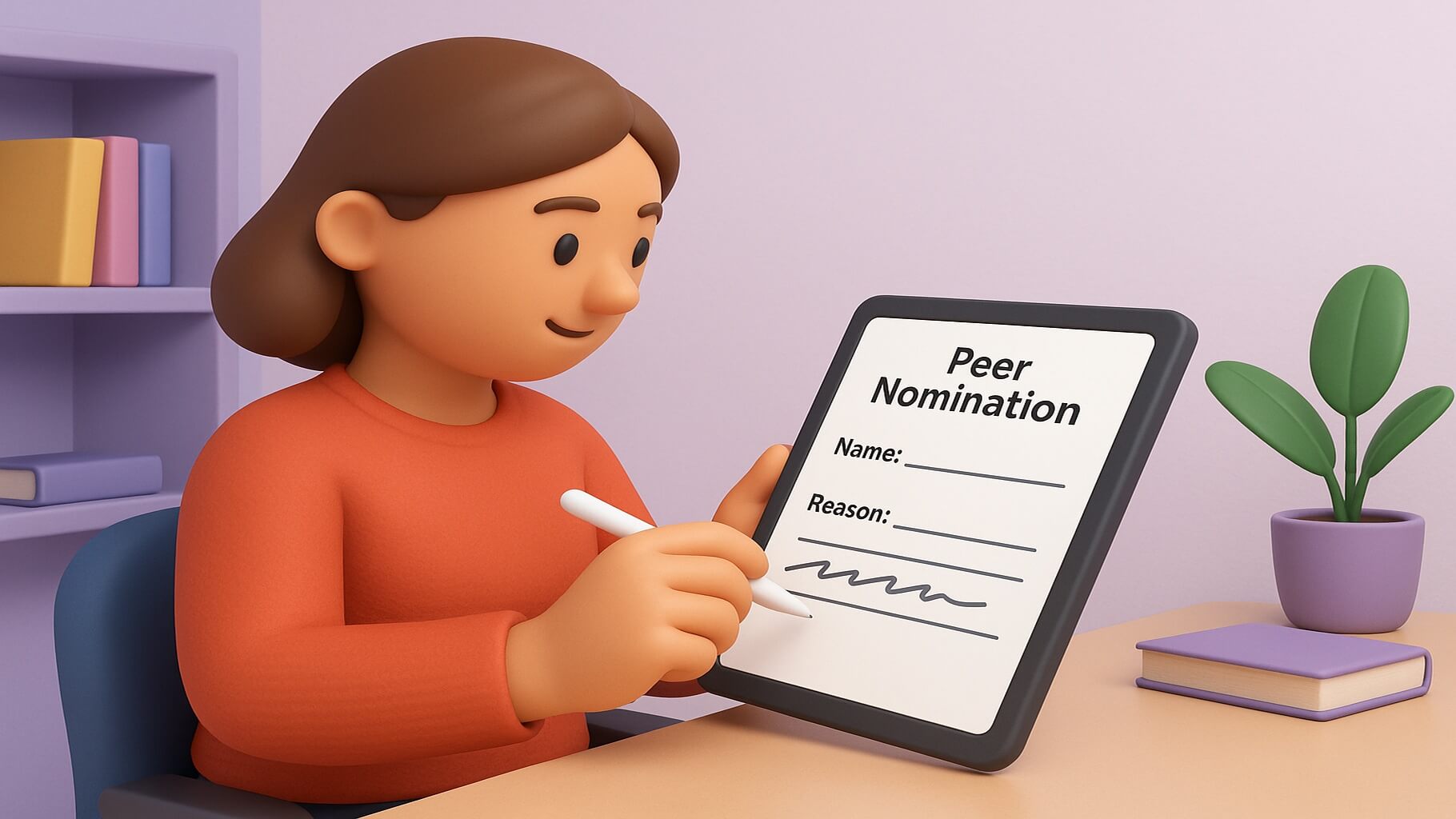
Matter provides comprehensive solutions for streamlining peer recognition while ensuring that nominations effectively capture and celebrate employee achievements across all organizational levels. The platform's automated features and customizable templates make it easy for employees to submit meaningful nominations that strengthen workplace culture and boost employee engagement.
Streamlining peer recognition with automated nomination collection
Matter's automated systems simplify the nomination process through seamless integration with Slack and Teams, making recognition a natural part of daily workflows. The platform's Feedback Friday automation ensures regular recognition by sending automated reminders that encourage consistent participation without creating an administrative burden.
Key automation features include:
- Slack and Teams integration that enables instant nomination submission within existing communication channels
- Feedback Friday automation that sends weekly reminders to maintain recognition momentum
- Automated celebration features for birthdays and work anniversaries that ensure no milestone goes unnoticed
- Intuitive setup process that allows leaders to implement the platform in minutes
The platform's peer recognition programs streamline the entire nomination process while maintaining focus on meaningful appreciation that drives employee engagement and strengthens team relationships.
Creating customizable peer nomination templates and examples
Matter offers beautiful, customizable kudos cards that enable employees to celebrate achievements, express gratitude, and align recognition with company values. These customizable templates can be adapted for individual anniversaries, company projects, or personal events, allowing colleagues to connect and appreciate their achievements.
Template customization features include:
- Beautiful kudos card designs that can be customized for specific achievements and company values
- Milestone-specific templates for birthdays, work anniversaries, and project completions
- Company initiative cards that align recognition with organizational goals and priorities
- Personal moment celebrations that strengthen workplace relationships and team bonds
Matter's employee nomination form templates offer structured guidance, helping employees craft compelling nominations while maintaining consistency across all recognition efforts.
Tracking staff recognition data and peer nomination analytics
Matter's analytics capabilities provide comprehensive insights into recognition patterns and program effectiveness through robust reporting features. The platform's unique coin-based reward system resets weekly to encourage authentic recognition while providing data on participation rates and engagement levels across the organization.
Analytics and tracking capabilities include:
- Recognition pattern analysis that shows participation trends across departments and teams
- Coin-based reward tracking that measures engagement through the weekly resetting reward system
- Program effectiveness metrics that demonstrate the impact of recognition efforts on workplace culture
- Comprehensive reporting tools that support data-driven decisions about recognition program improvements
The platform's employee rewards system features coins that can be redeemed for digital gift cards, charitable donations, or branded company merchandise, while providing valuable insights into recognition distribution and employee engagement outcomes.
Final thoughts about peer nomination examples
Effective peer nomination examples are important tools for strengthening workplace relationships, recognizing outstanding accomplishments, and cultivating an appreciation culture that promotes employee engagement and corporate success. When employees take time to formally acknowledge their colleagues' achievements, it creates positive ripple effects that strengthen team bonds and encourage continued excellence.
Building sustainable employee recognition through peer nominations
Sustainable recognition programs depend on providing clear guidance, consistent processes, and meaningful outcomes that motivate continued participation while ensuring that all deserving contributions receive appropriate acknowledgment. Organizations that invest in developing effective nomination systems create lasting improvements in workplace culture and employee satisfaction.
The key to long-term success is to include peer recognition into daily operations rather than as an occasional project. When employees understand how to identify and document noteworthy achievements, recognition becomes a natural extension of collaborative relationships that strengthen organizational culture.
Measuring the success of peer-to-peer recognition programs
Success metrics for peer recognition programs should include both quantitative measures, such as participation rates and submission frequency, as well as qualitative indicators, like employee feedback and improvements in workplace culture. Regular assessment helps organizations refine their approaches while demonstrating the value of recognition investments.
Effective measurement also involves tracking long-term outcomes such as employee retention, engagement scores, and team performance indicators that reflect the cumulative impact of recognition efforts. This comprehensive approach enables organizations to understand how peer nominations contribute to their broader organizational goals.
Ready to transform your peer recognition efforts with streamlined nomination processes, customizable templates, and comprehensive analytics that drive meaningful employee engagement? Schedule a demo with Matter today and discover how automated recognition tools can help you create a thriving culture of appreciation that celebrates achievements, strengthens relationships, and supports long-term organizational success through effective peer nomination programs.






















